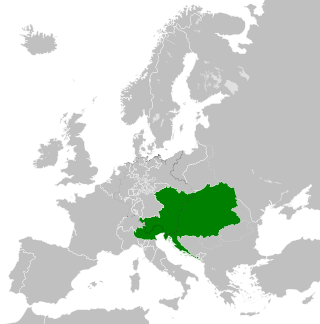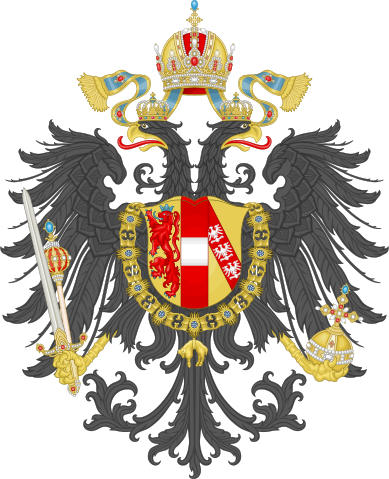More languages
More actions
| Empire of Austria Kaisertum Österreich | |
|---|---|
| 1804–1867 | |
 The Austrian Empire in 1815 (German Confederation in dotted lines) | |
| Capital | Vienna |
| Dominant mode of production | Feudalism |
| Government | Absolute monarchy (1804–1860) Constitutional monarchy(1860–1867) |
The Austrian Empire, officially known as the Empire of Austria, was a European great power in the 19th century that occupied multiple Central European nations under the hegemony of the Hapsburg monarchy. Converted from the Archduchy of Austria to an empire during the Napoleonic Wars, Austria was one of the main strongholds of absolutism in Europe and existed in this form until forced to compromise with the Hungarians and become the Dual Monarchy in 1867.
History
Foundation
In the early years of the Napoleonic wars Napoleon decided to declare himself as ‘emperor of the French’ on 18 May 1804, followed by his coronation on 2 December. In response fearing loss of influence and the imminent dissolution of the Holy Roman Empire, Francis II Hapsburg decided to declare himself Emperor Francis I of Austria.[1]
Napoleonic France won a decisive victory against the Austrians at Austerlitz on 2 December 1805 forcing the Austrians to sue for peace. On 6 August 1806 Francis abdicated as Emperor of the Holy Roman Empire, dissolving the Empire in response to the threat of renewed war with France and Napoleon's reorganisation of Germany.[1]
Metternich era
Klemens von Metternich rose to become an influential politician over Austria as leader of a reactionary government, becoming Foreign Minister in 1808, and later chancellor from 1821 to 1848. The defeat of Napoleonic France in 1814 allowed Austria to grow in strength and the subsequent Congress of Vienna allowed them to gain territory and influence. Austria exchanged the Austrian Netherlands, previously lost during the French Revolution, for Northern Italy; annexing Lombardy and the possessions of the former Venetian Republic. Austria also gained influence over the new German Confederation created as a replacement for the dissolved Holy Roman Empire.[2]
The feudal absolutist Metternich government was committed to counterrevolution, supressing attempted bourgeois revolutions for Italian unification in the Kingdom of Sardinia and the Kingdom of the Two Sicilies in 1821. As the ruling elite fought to keep control over their patchwork empire, the bourgeoisie slowly attempted to bring the industrial revolution to Austria, replacing workshops with capitalist factories during the 1830-40s. The growth of the bourgeoisie was hampered by the governments favouring of feudal landlords and its efforts to maintain the feudalist system, keeping the bourgeoisie relatively weak in Austria.[2]
Revolutions of 1848
In March 1848 a bourgeois democratic revolution erupted in Austria with the goal of abolishing absolutism and feudalism as well as attempts to allow freedom for the various oppressed minorities within the empire such as the Hungarians and Czechs. However, the Austrian bourgeoisie opposed this course of events due to its ties to the aristocracy and betrayed the revolution leading to the revolutions failure and the preservation of the empire. Although the main objectives failed to be achieved, the liberal bourgeoise managed to gain some concessions such as agrarian reform which allowed for a faster implementation of capitalism, though still impeded by the preservation of feudalism.[2]
Hungarian Compromise
During the 1850s and 60s the Austrian focus was on pacifying the Hungarian aristocracy but its position continued to weaken with failures abroad such as with a deterioration of relations with Russia during the Crimean War and a defeat in the war against Sardinia and France in 1859. Crucially Austria also lost the Austro-Prussian War in 1866 against Prussia and Italy, and the subsequent formation of the North German Confederation in 1867 meant the loss of the Hapsburg influence over the German states.[2] Following the military defeat the government of Friedrich Ferdinand von Beust concluded an agreement with the Hungarians in 1867 which turned the Hapsburg Empire into the Dual Monarchy of Austria-Hungary comprised of two parts: Cisleithania and Transleithania.[3]
References
- ↑ 1.0 1.1 Peter H. Wilson (2016). Heart of Europe: A History of the Holy Roman Empire: 'Sovereignty; A New Charlemagne' (pp. 161-163). ISBN 9780674058095
- ↑ 2.0 2.1 2.2 2.3 M. A. Poltavskii (1979). The Great Soviet Encyclopedia: 'Austria; Austria from the end of the 18th century to the 1860’s'.
- ↑ M. A. Poltavskii (1979). The Great Soviet Encyclopedia: 'Austria; The Hapsburg monarchy in the last third of the 19th century'.


